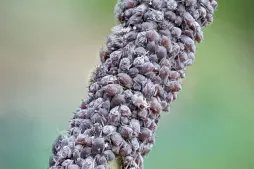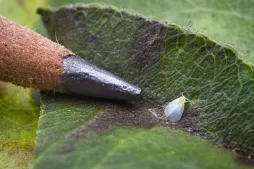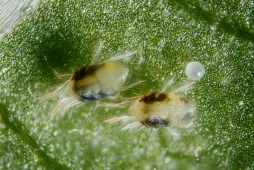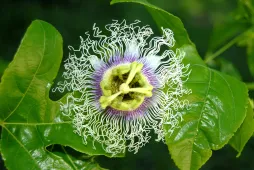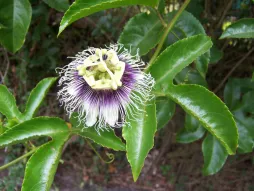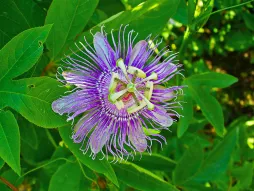Passiflora caerulea, blue passionflower
With its blue flowers, Passiflora caerulea is the most widely cultivated variety of passionflower in Europe. The plant comes to us from South America and belongs to the Passifloraceae family. The name was coined by Spanish Catholic missionaries. Observing the inflorescence, they saw it as a metaphor for Christ's sufferings (passions) during the crucifixion.
How to recognize blue passionflower, Passiflora caerulea?
Blue passionflower is a climbing shrub. Larger than passion flower (Passiflora incarnata), it can reach a height of twelve meters and a spread of four.
The woody stump gives rise to branching, voluble vines. They cling to their support via tendrils at the base of the leaves.
The alternate, palmate leaves have five to seven oval lobes. Foliage is medium to dark green and semi-evergreen. It disappears when the thermometer falls below 0°C.
When they look at a passionflower, gardeners see a flower about ten centimetres across, with whitish petals and sepals. They also see a crown of blue filaments surrounding green stamens and a raised pistil.
17th-century missionaries, on the other hand, saw in the inflorescence all the symbols of the crucifixion. The five petals and five sepals would represent ten of the twelve apostles. The three styles of the pistil symbolized the nails, while the five stamens represented the wounds inflicted on Jesus. As for the crown of filaments, it would recall the crown of thorns!
Blue passionflower produces an ovoid, fleshy berry. But this fruit is not the real passion fruit. It has a mild taste and can cause dizziness and upset stomach.
The leaves and roots are toxic if swallowed. Passiflora caerulea causes vomiting in animals and humans alike.
Our maintenance tips
Would you like your Blue passionflower to bear fruit? You may need to grow several specimens. Some self-sterile varieties need to be planted alongside others blue Passiflora for pollination to take place.
Watering
Water only when the substrate has dried on the surface (one or two centimeters).
Use non-calcareous water, such as rainwater or mineral water, at room temperature. Pour it over the soil, avoiding the foliage.
To prevent root rot, remove any water that collects in the dish or planter.
Repotting
Blue Passiflora are fast-growing. Choose a pot with holes at least 40 centimetres deep to give the plant room to develop its root system. You can line the bottom with a layer of clay balls or gravel to improve drainage.
Your plant needs a rich, draining substrate. You can mix equal parts topsoil and potting soil and add a handful of compost and sand. If you don't have any, a mixture for Mediterranean plants is also suitable.
Pour substrate into the hole. If you have provided a stake, install it in your pot now. Plant your Blue passionflower. The collar and root ball should be a few centimetres below the rim of the pot to leave a watering trough. Add potting soil up to the root ball. Tamp and water.
Your plant will cling to its support itself thanks to its tendrils. But you'll need to give it a little help when planting. Arrange the vines in a zigzag pattern along your wall, pergola or fence.
Fertilization
Apply a dose of compost at the foot of the plant.
To promote the growth of your Passiflora caerulea, apply fertilizer in spring and summer.
Apply flowering plant fertilizer to stimulate flowering.
Prune
Remove dead leaves. Using clean, sharp pruning shears, trim back dead branches. You can also shorten the stems to control the shape of your Blue passionflower
Plantation
When the risk of frost has passed, it's time to plant.
Soak your Passiflora caerulea to rehydrate the root ball.
The plant has extensive roots. Dig a hole of at least 40 centimetres in all directions to accommodate it. If your soil is heavy and tends to retain water, place two to three centimetres of clay balls or gravel at the bottom to improve drainage.
Prepare a mixture containing equal parts garden soil and potting soil. Add a handful of compost. Pour on a layer of substrate and plant your plant. The rootball should reach ground level.
Fill in the hole, compact and water. You can mulch with a mineral or organic material to keep the plant cool.
Blue Passiflora plants have tendrils at the base of their leaves, enabling them to hang on. Planted next to a low wall, trellis or pergola, your plant will climb naturally. But you can encourage it by guiding its vines along the support. It's best to run them in a zigzag or horizontal pattern to stimulate growth.
Cutting
Cutting is carried out during the strong growth phase, generally in spring and early summer.
Choose a stem with a soft tip and no flowers. Using a clean, sharp pair of pruning shears, remove a section of about fifteen centimetres with at least three nodes.
Remove the leaves at the base of the plant, keeping only the pair at the top. You can tie up the leaves or halve their size to limit evapotranspiration.
Prepare a pierced pot of a size suitable for your cutting (about ten centimetres in diameter). Pour a bed of clay marbles into the bottom, followed by a mixture of potting soil for seedlings and cuttings and sand (or perlite). Water generously
Use a pencil or pick to make a pilot hole. Plant your Blue passionflower.
Cuttings root more easily when smothered. Cover the pot with a transparent plastic bag or place it in a mini greenhouse. If you don't have one, a translucent plastic crate will do.
Place in semi-shade and air for a few minutes each day.
Diseases / Threats
Information
| Family | Passifloraceae - Passifloraceae |
| Type | Passionflower - Passiflora |
| Species | Passiflora caerulea - Passiflora caerulea |
| Lifecycle | Perennial |
| Foliage | Semi-evergreen |
| Exposures | |
| Substrats | |
| Planting methods |
Open ground In pots In tubs |
| Categories | |
| Tags |
Beginner Flowery Toxic |
| Origin |
South America |
| Hardiness (USDA) | 8b |
| Leaf color |
|
| Flower colors |
|
| Fruit color |
|
Discover plants from the same family













